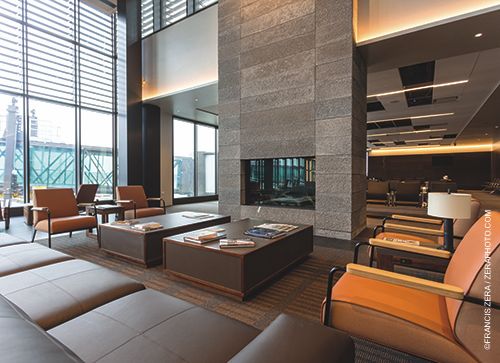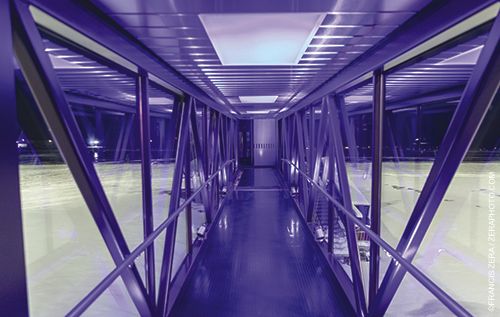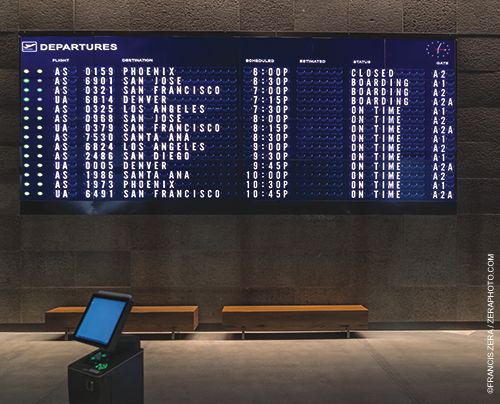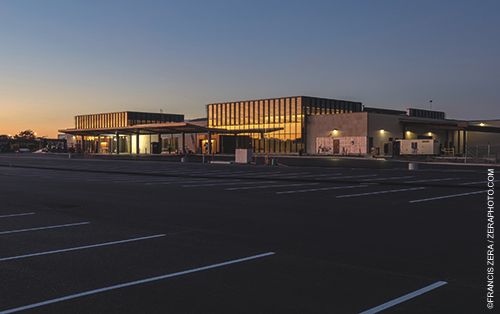After decades serving business and general aviation traffic, Paine Field-Snohomish County Airport (PAE) is adding scheduled passenger service out of a polished new terminal owned and operated by a private operator. The Everett, WA, airport will have 24 daily roundtrip flights to nine western U.S. markets when its schedule is in full swing this spring.
After decades serving business and general aviation traffic, Paine Field-Snohomish County Airport (PAE) is adding scheduled passenger service out of a polished new terminal owned and operated by a private operator. The Everett, WA, airport will have 24 daily roundtrip flights to nine western U.S. markets when its schedule is in full swing this spring.
 New service by Alaska Airlines and United Airlines is good news for travelers living in the northern Seattle metro area, who previously had to drive 50+ miles south to Seattle-Tacoma International Airport. But the new terminal provides passengers with much more than proximity. The $40 million terminal features upscale finishes and VIP amenities such as concierge service, floor-to-ceiling fireplaces and individual, private restrooms.
New service by Alaska Airlines and United Airlines is good news for travelers living in the northern Seattle metro area, who previously had to drive 50+ miles south to Seattle-Tacoma International Airport. But the new terminal provides passengers with much more than proximity. The $40 million terminal features upscale finishes and VIP amenities such as concierge service, floor-to-ceiling fireplaces and individual, private restrooms.
The 30,000-square-foot facility was developed, financed and built via a public-private partnership (P3) between Snohomish County and Propeller Airports. Per the 30-year lease agreement, Propeller owns and operates the new terminal and adjacent parking infrastructure. The private company manages public ground transportation such as taxis and ride share vehicles. The county will receive about $500,000 per year for rent, plus 2.5% of gross revenue during the first five years and 5% thereafter. The lease includes options for two 10-year extensions; revenue projections were not released. Annual enplanements are estimated at 550,000.
|
Project: New Terminal; New Commercial
Location: Paine Field-Snohomish Size: 30,000 sq. ft; 2 gates Cost: $40 million
Designer, Builder & Operator: Est. Annual Enplanements: 550,000 Daily Roundtrips: 24 Non-Stop Destinations: DEN, LAS, LAX, PDX, PHX, SAN, SFO, SJC, SNA Construction: Mid-2017 to Jan. 2019 Architect: Fentress Architects General Contractor: Fisher Construction Group Seating & Tables: Vitra Baggage Handling: Five Star Airport Alliance Parking: Republic Parking System Glass Boarding Bridges: JBT AeroTech
Interior Design: The Design Studio Security Exit Doors: dormakaba
Common-Use Infrastructure: Hand Dryers: Airblade; Airblade db, by Dyson
Notable Amenities: Floor-to-ceiling fireplaces; 20 individual restrooms (split equally between |
Airport Director Arif R. Ghouse notes that PAE had previous experience teaming with private companies to build infrastructure for aerospace tenants, but the recent terminal project was its first P3 venture to support passenger service. “With the explosion in population in the Puget Sound area and the demand increasing for more aviation options, this terminal allows Paine Field to meet that demand,” explains Ghouse. “People will now be able to fly out of Paine Field instead of having to go down to Sea-Tac.”
Construction of the two-gate facility began in mid-2017 and was completed in February Some routes originally scheduled to begin in February were delayed until March due to the partial federal government shutdown. The full schedule for PAE’s passenger terminal includes nonstop flights to Denver; Las Vegas; Phoenix; Portland, OR; and five California markets (see Facts & Figures on Page 9) for list of specific airports). Service is provided on Embraer E-175 aircraft.
Full-Circle Development
The recent addition of scheduled passenger service brings PAE back to its original roots. Paine Field was constructed in the 1930s by the Works Progress Administration to offset the effects of the Great Depression and provide the Seattle region with a commercial airport. But when World War II began, the Army Air Corps requisitioned the airfield to support the war effort. In the 1960s, the military relinquished control, and The Boeing Company moved in to develop and manufacture the iconic 747. Discussions about scheduled air service began in the mid-’70s, but as Boeing grew and other aerospace businesses came to the area, the airport ended up catering to industrial, business and general aviation traffic.
Enter Propeller Airports, a New York City-based firm that specializes in P3 airport projects. About four years ago, Propeller approached Snohomish County about constructing a terminal to bring in commercial air service. “Airlines had been expressing an interest in coming here and there was demand, but the county wanted to have minimal financial risk,” explains Ghouse. “That’s why we entertained the idea of working with Propeller. They were willing to put the money up and take the risk of building the terminal. There was no risk on the part of the airport for this project.”

Why was PAE an attractive prospect for private investment? “Sea-Tac is at capacity, and the region was really in desperate need for another airport,” relates Propeller CEO Brett Smith. “It was a very low-ri
sk scenario for the airport. The proposal allowed Paine Field to get a terminal with no tax-supported dollars as well as receive the economic benefit of commercial service at the airport.”
From the outset, Smith wanted the terminal to be a “step above” other U.S. airports. “Our goal was to bring civility back to air travel,” he explains, noting that he took inspiration from overseas facilities such as Zurich Airport. “We were doing it for the passenger experience. And as a private operator, we needed to show that the private sector can handle a project like this efficiently and get a superior product without having to spend taxpayer dollars.”
Upscale Furnishings, VIP Touches
The check-in area includes polished concrete flooring, wooden acoustic ceiling panels imported from Switzerland and counters topped with Italian marble. Flight information is displayed on a 24-foot-long, 9-foot-tall replica of a vintage Solari board behind the sleek counters. “No one makes the split-flip boards anymore; so we worked with Amadeus Air IT to recreate one using software,” says Smith. “It looks like a real Solari board and even makes the same noise.”

After passengers clear the TSA checkpoint (which includes the availability of PreCheck screening), they enter an open room lined with windows that provide expansive views of the tarmac and surrounding Pacific Northwest landscape. The central area resembles a large lounge with small groups of living room-style furniture—modular sofas, chairs, coffee tables, lamps and cases that display historic aviation items. The terminal’s two gates are located on opposite sides of the room, separated from the main central area by stand-alone floor-to-ceiling fireplaces. Individual lounge chairs are stationed near the windows facing
the tarmac.
 Designers furnished the gate areas with seating and occasional tables from Vitra. “The bench seating has polished aluminum finishes, so it’s shiny and very elegant,” notes Hendrik Woywod, global key account manager for Vitra. “That’s what they were trying to achieve with this terminal—a very elegant looking interior and unique appearance.”
Designers furnished the gate areas with seating and occasional tables from Vitra. “The bench seating has polished aluminum finishes, so it’s shiny and very elegant,” notes Hendrik Woywod, global key account manager for Vitra. “That’s what they were trying to achieve with this terminal—a very elegant looking interior and unique appearance.”
Each of the 156 Vitra MedaGate bench seats has two dedicated armrests with built-in power outlets. As such, passengers don’t have to vie for positions to charge their electronics or contort themselves looking for outlets on the floor or under seats. “That’s really unique,” observes Woywod. “Most airports are looking for efficiency and maximum capacity at the gate. At Paine, it is the other way around—it’s all about improving the experience.”
Tables are also equipped with power/charging outlets, and free high-speed internet access is available throughout the facility.
Instead of large restrooms with multiple stalls, the terminal features 20 private, individual restrooms that are all compliant with the Americans With Disabilities Act. Ten are located in the airside gate area; 10 are before the TSA checkpoint.
“The personal aesthetic is what I liked,” says Smith, who played a key role in the terminal design and interior selections. “It’s clean and timeless, and all of the finishes were really thought out.”

Ghouse likens the terminal’s look to a high-class hotel. “It’s a beautiful building,” he remarks. “A major international airport has VIP lounges; but in this case, the entire terminal all 30,000 square feet—feels like a VIP lounge.”
Glass boarding bridges add to the upscale feel. “They are just beautiful,” Smith relates.
Concessions include an 18-seat restaurant and bar run by Beecher’s Handmade Cheese, a well-known local purveyor. Diners can eat at bistro-style tables or use tables in the main lounge area.
Additional Amenities
True to its mission of providing a superior travel experience, PAE offers valet parking and concierge service. “If you are a regular user of valet parking, by the time you pull up to the front door of the airport, your license plate will be scanned and we’ll know who you are,” Smith says. “One of our parking attendants will greet you by name and ask when you are returning. Then, you will receive a text message with a ticket number so there’s no paper stub to lose. And when you return, your car will be angle parked at Baggage Claim. Our goal is to get passengers from car to gate in 10 minutes or less, and from gate to car in five minutes or less.”

Propeller also has future plans to provide concierge services—everything from securing local theatre tickets and restaurant reservations to having dirty laundry cleaned and pressed by the time a traveler returns.
Smith believes other U.S. terminals can provide similar amenities. “There’s no reason all airports can’t be this nice,” he says. “Money generated at airports can support a project like this. You see this type of service all over the world. We want our customers to want to use this airport. By offering a facility that lowers their stress levels, gets them through Security quickly and gives them a comfortable place to wait for their flight, we can do that.”
Working Together
Both Smith and Ghouse note that a good working relationship has been essential to the P3’s success. “It’s been an exciting project to work on, and we both had to understand each other in terms of how we each operate,” Ghouse says. “The ability to have two groups work together is critical to ensuring we’re delivering a successful project.”
Smith emphasizes the importance of engaging the local community in P3 airport projects. “First of all, the private entity must have the financial backing to take a project from concept to operation in an efficient manner that is in line with the goals of the community. A lot of people are nervous that something like this will cost jobs. It is actually quite the opposite. We’ve added 10 to 15 employees, and no one lost their job.”
Smith recommends involving local businesses and contractors whenever possible. “That’s what I love about this project. You can see the pride generated by the people working on the terminal. It’s evident they put a lot more effort into their work knowing that their relatives will be traveling through it.”

Airport officials say that Propeller and its contractor companies expect to employ up to 300 people to support commercial operations. PAE plans to add 29 employees in operations, maintenance and police/fire services to ensure the airport can safely and securely support commercial flights, says Ghouse.
In addition to supporting new commercial service, the terminal project is also expected to generate related economic development.
“We have 200 aerospace companies alone here in Snohomish County, and 70 tenants at the airport,” Ghouse explains. “There’s a lot of business traffic coming up this way. In order to encourage more business growth, a lot of companies are looking for air traffic service they can connect to. This project will attract more business on this side of the county, because travel options will now be more convenient for them. And at the end of the day, it’s all about jobs.”


 facts&figures
facts&figures

